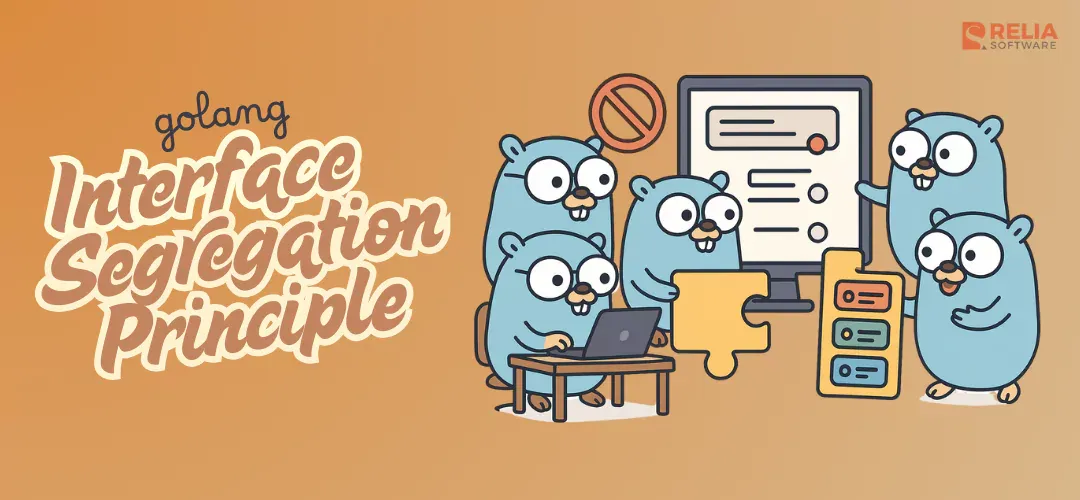The Interface Segregation Principle (ISP) is a crucial guideline in object-oriented design, advocating for the creation of specific and lean interfaces. It is one of the five SOLID principles introduced by Robert C. Martin, which collectively aim to improve software maintainability and extensibility.
This approach not only simplifies the design and interaction between objects but also enhances code maintainability and flexibility. In this article, we will explore further about the Interface Segregation Principle in Golang with practical examples.
>> Read more about SOLID in Golang:
- Detailed Code Examples of Dependency Inversion in Go
- Practical SOLID in Golang: Single Responsibility Principle
- Practical SOLID in Golang: Open/Closed Principle
- Practical SOLID in Golang: Liskov Substitution Principle
- Best Practices For Dependency Inversion in Golang
What is the Interface Segregation Principle (ISP)?
The Interface Segregation Principle states that no client should be forced to depend on methods it does not use. It advocates for creating small, specific interfaces rather than large, general-purpose ones.
The Interface Segregation Principle (ISP) is a fundamental concept in object-oriented design that plays a pivotal role in the development of robust and maintainable software systems. This principle is part of the SOLID acronym, a set of guidelines aimed at enhancing software design and architecture, making systems more scalable, flexible, and easier to manage.
ISP focuses on the importance of creating lean and focused interfaces. In object-oriented design, an interface is a contract that defines the methods a class must implement. However, when interfaces become "fat" or overly broad, they can include methods that are irrelevant to some of their implementing classes.
ISP suggests segregating these large interfaces into smaller, more specific ones so that classes only implement the methods that are necessary for their operation. This approach leads to a cleaner, more modular codebase where each interface serves a distinct and focused role.
Importance of The Interface Segregation Principle in Software Development
The significance of ISP in software development cannot be overstated. It directly impacts the maintainability, flexibility, and scalability of software applications. By adhering to ISP, developers can create systems that are easier to refactor, extend, and test. This is because changes to one part of the system are less likely to impact unrelated parts, thanks to the decoupling of interfaces and their implementations.
Furthermore, ISP encourages the development of more reusable code, as smaller, well-defined interfaces are more likely to be applicable across different parts of an application or even across projects.
The Problem ISP Solves in Object-Oriented Design
In object-oriented design, one of the challenges is managing dependencies between classes. Large, monolithic interfaces contribute to this problem by creating unnecessary dependencies.
For example, a class required to implement an interface with methods it doesn't use is indirectly dependent on behavior it doesn't need. This can lead to bloated codebases, where changes to a single method in an interface may require modifications to classes that don't even use that method. Additionally, this setup complicates testing, as classes end up with more responsibilities than they should have, violating the Single Responsibility Principle (SRP).
ISP addresses these issues by advocating for the segregation of interfaces based on the client’s needs. By ensuring that interfaces contain only the methods required by their consumers, ISP reduces the coupling between classes. This segregation not only simplifies the implementation of classes but also enhances the system's adaptability to change.
As software grows and evolves, the ability to modify or extend functionalities without affecting unrelated components becomes invaluable, making ISP a cornerstone of sustainable software development.
Why to Apply The Interface Segregation Principle in Go?
Go language's interface system is uniquely designed to encourage the application of the Interface Segregation Principle (ISP), making it a powerful tool for building maintainable and scalable software.
Characteristics of Go interfaces, such as implicit implementation and the promotion of small, focused interfaces, naturally align with ISP by ensuring that types only need to implement the methods that are relevant to their functionality. This leads to a high degree of decoupling between components, allowing for more modular software design and easier refactoring.
The standard library in Go exemplifies this approach, with interfaces like io.Reader and io.Writer demonstrating how small, composable interfaces can be used to build complex behaviors. This design philosophy not only enhances modularity and testability but also improves the overall flexibility and maintainability of software systems.
By advocating for the use of small interfaces and composition over inheritance, Go effectively promotes better separation of concerns and a clearer, more understandable codebase. The result is a programming environment that inherently guides Golang developers towards creating robust, efficient, and adaptable software architectures.
Implementing the Interface Segregation Principle in Go with Code Sample
Imagine we have a system designed to manage content for different types of media - articles, podcasts, and videos. Initially, we define a single interface ContentManager that includes methods for editing, publishing, and playing content. This design forces implementations for articles and podcasts to depend on the Play method, which they don't use, thereby violating ISP.
package main
type Content struct {
Title string
Body string
}
type ContentManager interface {
Edit(content *Content)
Publish(content *Content)
Play(content *Content)
}
// ArticleManager has to implement Play method, which is irrelevant for articles.
type ArticleManager struct{}
func (a *ArticleManager) Edit(content *Content) {
// Implement editing logic
}
func (a *ArticleManager) Publish(content *Content) {
// Implement publishing logic
}
func (a *ArticleManager) Play(content *Content) {
// Irrelevant for articles
}
func main() {
// Example usage
}Let’s see now, we will refactor the code above a little bit to following the ISP
- Identify Responsibilities: Start by identifying the distinct responsibilities in the
ContentManagerinterface. In our case, editing, publishing, and playing content are clearly separate concerns. - Segregate Interfaces: Create separate interfaces for each identified responsibility. This means defining
Editor,Publisher, andPlayerinterfaces, each with only the methods relevant to their specific functionality. - Implement Segregated Interfaces: Refactor existing types to implement only the interfaces relevant to their functionality. For instance,
ArticleManagerwould implementEditorandPublisher, but notPlayer.
package main
type Content struct {
Title string
Body string
}
// Segregated interfaces
type Editor interface {
Edit(content *Content)
}
type Publisher interface {
Publish(content *Content)
}
type Player interface {
Play(content *Content)
}
// ArticleManager now only implements Editor and Publisher
type ArticleManager struct{}
func (a *ArticleManager) Edit(content *Content) {
// Implement editing logic
}
func (a *ArticleManager) Publish(content *Content) {
// Implement publishing logic
}
// VideoManager could implement all three interfaces, for example
type VideoManager struct{}
func (v *VideoManager) Edit(content *Content) {
// Implement editing logic specific to videos
}
func (v *VideoManager) Publish(content *Content) {
// Implement publishing logic for videos
}
func (v *VideoManager) Play(content *Content) {
// Implement play functionality for videos
}
func main() {
// Example usage demonstrating the flexibility of the new approach
}After applying ISP by segregating the ContentManager interface into Editor and Player. We achieve several benefits:
- Reduced Irrelevance: Implementing classes like
ArticleManagerno longer need to implement methods (Play) irrelevant to their functionality. - Increased Flexibility: It's easier to add new content types or functionalities by simply implementing the necessary interfaces without affecting existing implementations.
- Improved Maintainability: Changes to a specific aspect of content management (e.g., editing) are now localized to the
Editorinterface, reducing the impact on unrelated functionalities.
This refactoring clearly demonstrates the power of ISP in creating more maintainable, flexible, and understandable code by ensuring that classes only implement the interfaces that are relevant to their operation.
Best Practices for Using Interface Segregation Principle in Go
Tips for Designing Lean Interfaces
- Start Small: When defining a new interface in Go, start with the minimum set of methods required for the intended functionality. It's easier to add more methods later than to remove unnecessary ones.
- Focus on the Client's Needs: Design interfaces based on what the clients (i.e., the types or packages that will use the interface) need, rather than what the server (i.e., the type that implements the interface) can provide. This client-centric approach ensures interfaces remain lean and relevant.
- Use Composition: Go encourages composition over inheritance. Apply this principle to interfaces as well by composing smaller interfaces into larger ones as needed, rather than defining large, monolithic interfaces from the start.
How to Identify When An Interface Needs To Be Segregated?
- Review Interface Implementations: Regularly review your interface implementations. If you find a type that implements an interface but throws a "not implemented" error for some methods, it's a clear sign that the interface may need segregation.
- Analyze Dependencies: If adding a new method to an interface forces changes in types that don't use the new functionality, consider segregating the interface to avoid unnecessary dependencies.
- Solicit Feedback: During code reviews, ask peers for feedback on your interfaces. If someone finds them confusing or bloated, it might be time to apply ISP and break them down.
How Can Your Golang Team Effectively Apply The Interface Segregation Principle?
Take advantage of the role of documentation and team communication while implementing ISP in your Go project.
- Document Interface Intentions: Clearly document what each interface is for and what responsibilities it encapsulates. This documentation helps team members understand why interfaces are designed a certain way and when they should be used or extended.
- Communicate Changes: When you segregate interfaces or introduce new ones, communicate these changes to your team. Explain the rationale behind the segregation to ensure everyone understands the benefits and how it affects their work.
- Promote Best Practices: Encourage your team to adopt best practices for interface design and ISP application. Regular discussions, code reviews, and refactoring sessions can foster a culture of continuous improvement and learning.
- Leverage Interface Examples: Use well-designed interfaces from the Go standard library (e.g.,
io.Reader,io.Writer) as examples to illustrate effective interface design and the benefits of ISP. These examples can serve as benchmarks for designing lean and focused interfaces.
>> Read more about Golang:
- Instruction For Using Golang Generics With Code Examples
- Understanding Golang Ordered Map with Code Examples
- What Are New Features in Golang sync.Once?
- Detailed Guide for Simplifying Testing with Golang Testify
- A Comprehensive Guide To Dockerize A Golang Application
- What's New in Go 1.21 Release?
- [Hands-on Guide] How to Implement Clean Architecture in Golang?
Conclusion
In wrapping up our exploration of the Interface Segregation Principle (ISP), a key takeaway is its foundational role in fostering maintainable and scalable software. ISP champions the creation of lean, purpose-driven interfaces, ensuring classes or structs implement only what's necessary, thereby avoiding the pitfalls of overburdened interfaces. This principle not only aligns perfectly with Go's interface system, which promotes implicit implementation and composition, but also offers universal value in software design by minimizing unnecessary dependencies and enhancing modularity.
The resultant effect on software is profound: systems become more adaptable, easier to refactor, and simpler to extend, embodying the ideals of resilience and flexibility. As you embark on future projects, integrating ISP into your design strategy promises to streamline development processes and yield software architectures that are robust, scalable, and poised to meet the evolving demands of technology and business alike.
Embracing ISP, along with the broader SOLID principles, will undeniably elevate your software development endeavors, steering them towards greater success and longevity.
Follow and Contact Relia Software for more information!
- golang
- development

